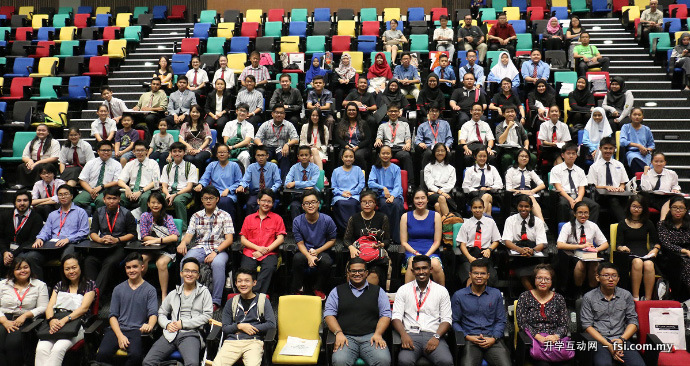
Curtin Sarawak geology students on their way through the Great Cave of Niah to carry out their research and mapping activities
Miri – 6 June 2011 – Geology is a fascinating subject to study at Curtin University, Sarawak Malaysia (Curtin Sarawak) because students learn about the diversity of the rocks that cover the surface of our planet Earth.
Recently, however, a group of Third Year Applied Geology students of the university have been taking their studies even deeper – both literally and figuratively – since they started working underground.
Ten geology students are now conducting research in the caves at Niah National Park under the direction of the head of the university’s Applied Geology Department, Dr. Franz Kessler, and the supervision of senior lecturer Dr. Dominique Dodge-Wan. The overall aim of their final year project work is to reach a better understanding of how the caves formed.
The Niah Caves are well known for their large cave swiftlet population, bird nest collection industry, archaeological evidence of human occupation (including an approximately 40,000-year-old skull) and unique cave paintings. However, the details of how and when the caves themselves were formed have not been studied in detail – until now.
To understand the caves’ formation, the students are mapping in detail the cave passages, sediments, stalagmites and stalactites, as well as key features visible in cave ceilings and walls, such as bedding planes, joints and faults. To date, they have produced the first published map of the famous Painted Cave, a complex cave which is also home to a rare type of stalagmite colonised by photosynthetic cyanobacterial organisms.
In order to undertake this project, which has the approval of the Sarawak Forestry Department and Sarawak Forestry Corporation, the students have had to modify survey methods and equipment commonly used above ground to suit the particular subterranean environment. They have been surveying to produce maps, transverse and longitudinal cross-sections, and will be using specialised software to better visualise the caves in 3D.
Access to the Painted Cave is an arduous walk via a forest walkway several kilometres long, followed by paths and steps through the equally famous Traders Cave, then through the Niah Great Cave (where the smell of guano is omnipresent) and finally, out the other side of the mountain. As a result, the Curtin students are becoming increasingly fit and geared up to the physical demands of this type of field work.
Dr. Dominique commented that, in the course of their work, they have shown great stamina, enthusiasm, organisational skills, as well as the ability to think in 3D.
“It is also exciting that our students have this opportunity to obtain new geological data from such a well known and unique site,” Dr. Dominique said.
According to her, the cave development appears to have been a complex process, involving several phases of dissolution and cave filling with sediments, guano, and cave mineral deposits as well as ceiling collapse.
“The students’ observations and measurements will help unravel the sequence of geological events leading up to what we see underground today,” she added.
Dr. Dominique disclosed that findings to date suggest that the Painted Cave is only one of several levels of cave passage, now abandoned by groundwater in favour of lower, wetter cave passages deeper under the hills, some of which may even be totally flooded.
As rivers at the surface eroded the hills into karst towers, a parallel process was occurring underground with a deepening of the cave passages. Apparently, the caves that visitors are able to admire represent only a small fraction of the cavities in the whole rock formation.
The work by the students is on-going and in the second semester of 2011, they plan to carry out more mapping activities, both above and below ground, to test ground, surface and cave drip waters and to sample limestone rocks for further analysis.
If any new caves are found, the students will add them to a database and observe and document their morphology. The studies will lead to a better understanding of the unique tropical karst landforms.
In addition, they will have the opportunity to participate in mapping activities in Niah’s Great Cave with scientists from universities in the United States and Canada, who are also interested in subterranean microorganisms.
Third Year student Tajul Rijal describes the work the geology students are carrying out as ‘a fusion between sanctum and textbook’.
“We learn new things, and at the same time, it is very fun and challenging. We thank our supervisors for their help during our project. We hope to achieve good results in the research at the Niah Caves and that they will be informative to the geology community,” he said.
According to Tajul, exploring a cave is akin to exploring the human heart.
“It is deep and mysterious. You don’t know what awaits you, but within lies greatness and beauty,” he commented.
For more information on Curtin Sarawak and the Department of Applied Geology, visit the university’s website at www.curtin.edu.my.

Curtin Sarawak final year geology students discussing survey results at one of the entrances to Niah_s Painted Cave

Stalagmites, fallen blocks and other cave features being surveyed in the Painted Cave at Niah by Curtin Sarawak geology students

Some of the Curtin Sarawak geology students conducting a survey of the sediments inside the Painted Cave as part of their underground geological mapping activities.










